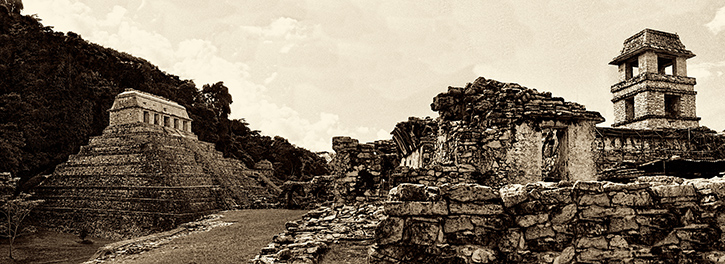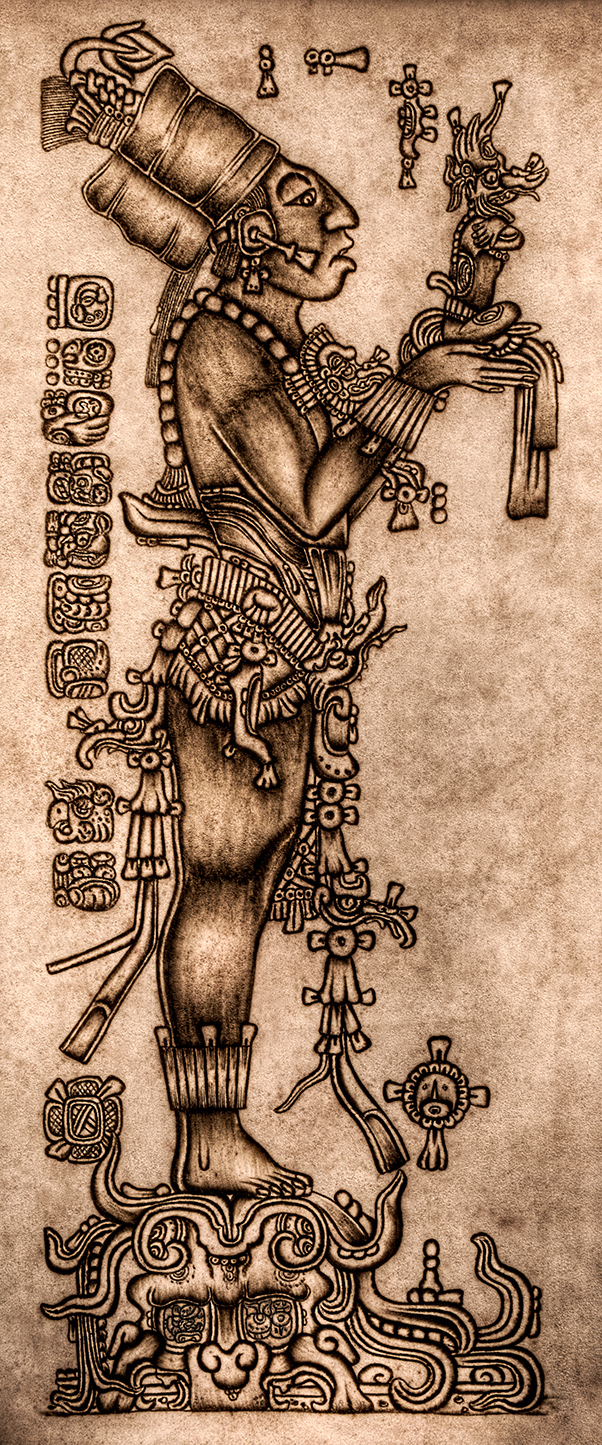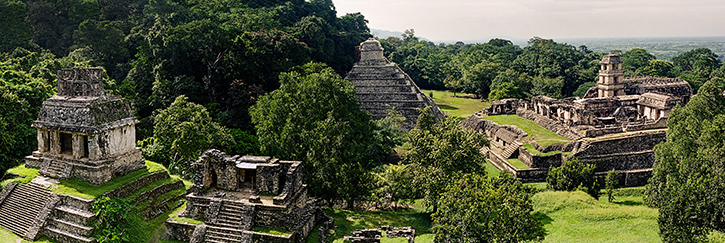Chapter 17: time travel to the stone age

Nothing prepares you for the sight of this massive pyramid and the experience of the climb to the top. Can you see the man up there? (fragment, click to see the complete ).
If you want to know what this blog is about…
The influence of one single book
When we say stone age we always think about prehistoric caves, Neanderthals, saber- toothed cats and the like. We tend to think of “industrial ages” as homogeneous times covering the whole world, and that’s wrong. Some Amazonian tribes still live in the stone age. So did all the pre-Columbian civilizations of Central America, the Maya, the Aztec, and all the others that existed before and at the time with them.
I read Gary Jennings’ Aztec in 1990, or so. I am a big Jennings fan. There is no arguing he was a dirty-minded writer that could make the hair on your neck stand on end with the sexual nastiness in his books which, for me, was way too disgusting at times. That said, there are very few historical novel writers that can take you back in time the way he did. Through Aztec, I saw Tenochtitlan, met the Aztecs and other Mesoamerican cultures of the time (around 1500 AD), visited Teotihuacan, and learned how these people of the stone age lived. I walked their streets, saw them dress, eat, fight, live, die… I was totally immersed. After Aztec, I read quite a few books about pre-Columbian cultures of Mesoamerica, mostly about the Maya, and knew I would go visit some day. I finally got there in 2001.
A stone age paradox
There is much we know about the Aztecs, but there is very little of their civilization that survives, because when the Spanish arrived the Aztec empire was at its highest and they fought until total destruction. The conquistadores were thorough in their efforts to behead the empire and destroy its culture so they could more easily enforce their own rule and beliefs. Mexico DF stands in the ashes of Tenochtitlan, the amazing Venice-like capital of the Mexica, as they called themselves, totally destroyed, the channels and lakes desiccated.
This is not a writing to criticize the steel-clad invaders in favor of the stone age empire. I already talked about this in another blog post about heroes. The Aztec was a bloody empire which ruled with ruthless efficiency. Same as most other empires in the world. The Spanish had simply better tools and, at the time, stronger determination. The Aztec empire was toppled by less than 200 Spanish soldiers and some 30 horses. They overcame using technology, but also politics. They raised all the subdued states around Tenochtitlan against the central power. And they inadvertently brought new germs that decimated the population. The final result is that there is little remaining of the Aztec Empire.
The Maya, however, are another story.
The classic Maya civilization of pyramid builders collapsed by itself centuries before the Aztec appeared. The Maya, and the Aztec, were very advanced civilizations, in amny ways akin to the Greek. They built wonderful state cities that constantly fought each other. They were magnificent astronomers, mathematicians, but also poets, writers, artists. They had universities, zoos, games…
The Maya still exist nowadays, and they keep their culture, language and believes in a way, but their majestic cities were devoured by the jungle. It was probably John Lloyd Stephens, along with artist Frederick Catherwood who brought the attention back to these ruins with their travel books full of wonderful drawings in the mid 19th century. Many cities and sites have been excavated and restored since, and there are still more to come. Only a small part has been retrieved from the green. However, what we can visit right now is simply breathtaking.
Palenque against Chichen Itza
First thing you have to decide when visiting all those sites is whether you want to be a tourist or a journeyer. This is going to be of mayor transcendence and will directly affect your experience. You can loathe to be in a wonderful place if the time is wrong. Happened to me in Chichen and besides it was the site I visited last, so the effect was even worse. Let me explain.
Palenque is lost in the jungle of Chiapas. It is not on the way to anywhere. There is nothing else near Palenque of general tourist interest. In order to visit Palenque you need to take a plane to Villahermosa, Tabasco, where you can see some Olmec Heads, but it is too far to justify a journey there. From Villahermosa you take a bus or a van and drive about four hours into Chiapas. You visit Palenque and then take the van back and the plane away. You have to want to see Palenque and you need to specifically go there in order to see it. It takes three days for a seven hour visit.
Of course, it is worth every single minute. There are very few people there, they know where they are, they respect, listen watch, walk silently. Journeyers. The guides are proud of what they are showing and get into depths that are not usual. The visitors make interesting questions that shed light in details you had not previously seen. The heat and humidity are overwhelming and you take all the shade you can in the silence only altered by the wind on the leaves and the spider monkeys howling in the jungle trees above you. And there, in the middle of it all, these ancient buildings of overwhelming beauty, crammed with bas-reliefs of such detail…
This heat lets the guides take you around the Palace and test first hand how efficient the Mayan cooling system was. You move three meters into the building and all heat vanishes. Amazing. The buildings are full of engraved images and hieroglyphic writing in bass-relief. The Maya of Palenque, around 800 AD, had flowing water, toilets and many other luxuries we consider modern. The pyramid, one of the very few used as a tomb, keeps the remains of king Pakal the Great, inside a sarcophagus the cover of which is so big it had to be placed inside before the pyramid was built. The engravings on this lid of over 4 tons are exquisite.
Walking through Palenque is one of the most amazing experiences of time travel to the stone age I have experienced. The sense of communion, of intimacy, is just uncanny. You are almost then.

The Mayan Temple of the Inscriptions and Palace of Palenque. One of the most special archaeological sites in the world one can visit. I really hope to return some day… (click to enlarge)
Chichen Itza is beautiful. Much bigger than Palenque and, in some ways, more spectacular. The pyramid of El Castillo is one of the most grandiose and well preserved. The problem in Chichen Itza is that it lies in the middle of the road from Merida to Cancun, and that Cancun is a massive touristic resort. Thousands of tourists go to Cancun to enjoy the beaches, the sun and the turquoise waters of the Caribbean. They are looking for some easy time, American style malls and entertainment for the evenings, pizza, beer… However, the tourist agencies create packs that include stay, food and some visits to exotic archaeological sites like Chichen Itza or Tulum. All this mass of tourists does not really care to visit these places but, since it is included and not too far, they go.
The result is that Chichen, and Tulum, are totally overcrowded. And they are not overcrowded by people who want to see the site, they are people who do not really care, invade restricted areas, throw plastic bags, cans, tissue paper, cigarette butts or whatever to the ground, call one another from the distance, argue, protest, even add graffiti to the stones, so we know they were there… the guides tell their grey story without interest to an audience that is bored by explanations. No time travel there. No intimacy. Just a feeling of waste and disrespect. A display of general ignorance and despise. I have seen a middle-aged woman cross the chain that restricts access to a little shrine in Tulum, sit on a window ledge over a thousand years old, drink her Coke while she smoked a cigarette, put out the butt on the ledge, leaving it there afterwards and throw the empty can inside the shrine. Her buttocks left a heart-shaped shadow of sweat on the stones, and she just walked away. My wife got her to retrieve the butt, but nothing else. Going to a place you love and see it be desecrated is no way to enjoy it. Better not to go. It can be really hurtful and depressing. I had a similar experience in Angkor Wat, but that is a story for another day.

The pyramid of El Castillo, also known as the Temple of Kukulkan, and the Temple of the Warriors dominate the center of the Chichen Itza Mayan archaeological site in the Mexican state of Yucatan (click to see complete).
Journeyer vs. tourist
So, you have to choose, journeyer, tourist. There are lots of places where being a tourist is pretty fine with me too. For the rest, the ones that actually matter to me, the choice is not a matter of cost. It’s a matter of attitude, of respect. If you are a journeyer, make sure you go to such places pretty early, as soon as they open, and enjoy them the way they are meant to be. Tourists seldom catch the worm. Most of the times, making the effort to arrive early will make the difference between traveling in time to the stone age (or the Roman empire, or wherever) and traveling to hell.
So read, read and read, before you go to those special places, and fully appreciate what you are going to see. Then do whatever it takes to see it in the right conditions, let your passage be unnoticed, or if noticed for the better, and come back a journey the richer.

Pyrography on leather of Chan Bahlum II, son of Pakal, the greatest king of Palenque. The original is a bas-relief located in one of the temples in Palenque (click to enlarge).
About the Pictures
All the panoramas you see here and others you can find in this gallery are photo-mergings of several HD scanned 35 mm negatives. Most of them are wider, but I cut them so you can see some detail. The picture of Chan Bahlum is a HDR made out of 5 digital pictures of this pyrography on leather shot under direct sunlight. I often make HDR of images that don’t need a high dynamic range, like this one, because the resulting effect is often nice. In other occasions I just use one of the five and discard the HDR. This pyrography decorates my room, as well as the Pyramid of the Sun from Teotihuacan and the spiral staircase of Giuseppe Momo.
This pictures can be printed in photo paper, canvas, metal or acrylic surface from 8″ to 108″, or in greeting card format. You can check them by clicking the images above. I am all in for customizing pictures. All of them can be retouched in many ways, texts added, altered, changed or deleted. Ask freely.
Related Posts
2 Responses to Chapter 17: time travel to the stone age
Leave a Reply
« Chapter 16: remembering Apollo 11 Chapter 18: of castles and sieges »










Your description of the woman with the cigarette butt and Coke can reminded me of an experience I had in Egypt. I was with a group inside a tomb in the Valley of the Kings. A man tried to scratch his initials on the wall. When I yelled at him and drew the attention of the guide, the woman with him said,”What different does it make to you? You’re not Egyptian?” She didn’t understand that he was not only showing no respect for the past, but no respect for the future. It’s up to all of us to preserve these special places for future generations. They are not just part of a country’s history, but are part of the history of all mankind.
Exactly. That something so obvious has to be explained to a grown up is rather disheartening. Particularly when that somebody is actually spending time and money in visiting those places.